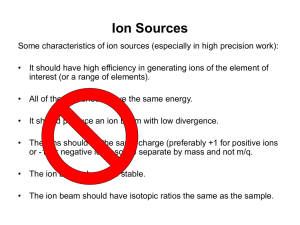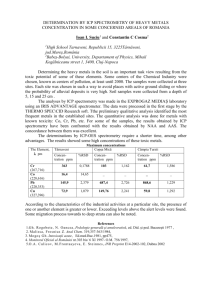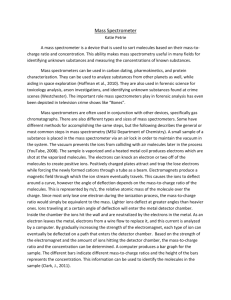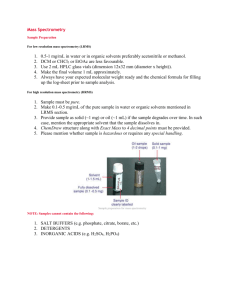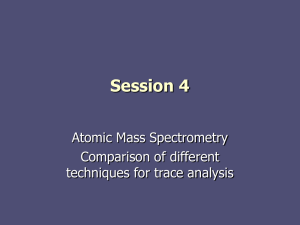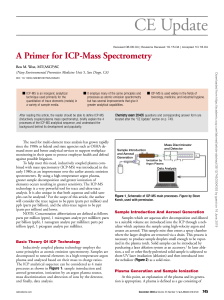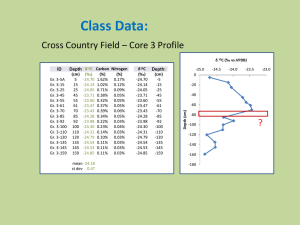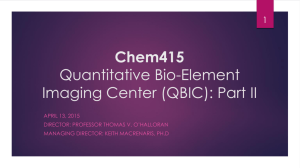Analytical Techniques
advertisement
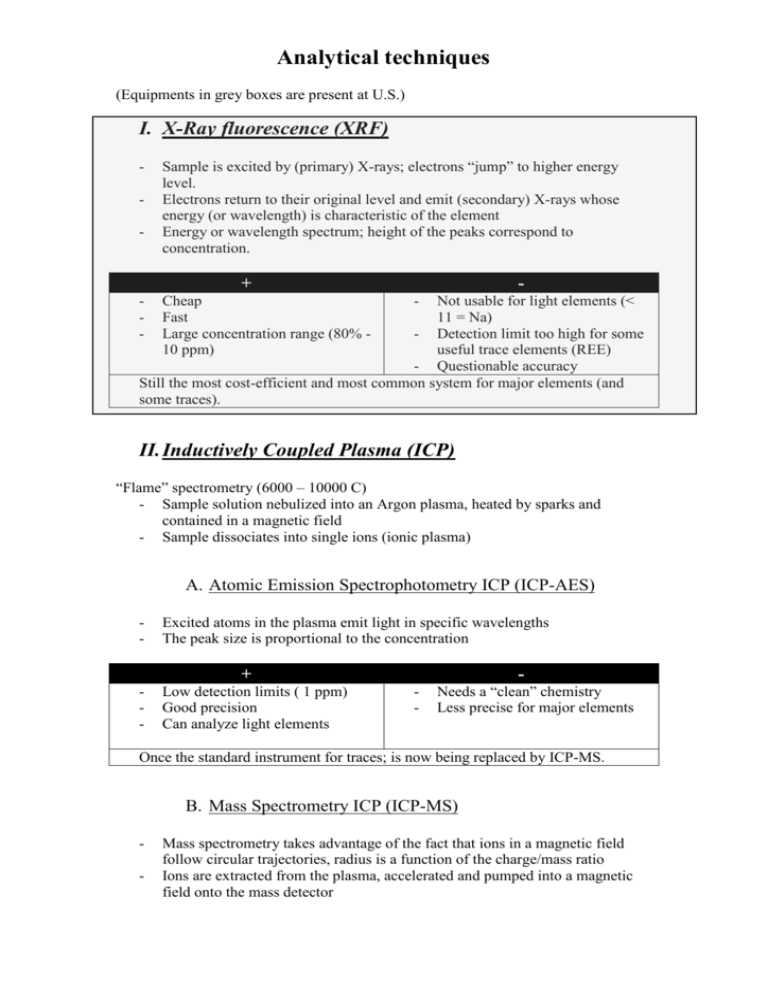
Analytical techniques (Equipments in grey boxes are present at U.S.) I. X-Ray fluorescence (XRF) - Sample is excited by (primary) X-rays; electrons “jump” to higher energy level. Electrons return to their original level and emit (secondary) X-rays whose energy (or wavelength) is characteristic of the element Energy or wavelength spectrum; height of the peaks correspond to concentration. + - Cheap Fast Large concentration range (80% 10 ppm) - Not usable for light elements (< 11 = Na) - Detection limit too high for some useful trace elements (REE) - Questionable accuracy Still the most cost-efficient and most common system for major elements (and some traces). II. Inductively Coupled Plasma (ICP) “Flame” spectrometry (6000 – 10000 C) - Sample solution nebulized into an Argon plasma, heated by sparks and contained in a magnetic field - Sample dissociates into single ions (ionic plasma) A. Atomic Emission Spectrophotometry ICP (ICP-AES) - Excited atoms in the plasma emit light in specific wavelengths The peak size is proportional to the concentration + - Low detection limits ( 1 ppm) Good precision Can analyze light elements - Needs a “clean” chemistry Less precise for major elements Once the standard instrument for traces; is now being replaced by ICP-MS. B. Mass Spectrometry ICP (ICP-MS) - Mass spectrometry takes advantage of the fact that ions in a magnetic field follow circular trajectories, radius is a function of the charge/mass ratio Ions are extracted from the plasma, accelerated and pumped into a magnetic field onto the mass detector + - Very low detection limits ( down to 1 ppb for modern instruments) Good precision Can analyze light elements Limited isotopic capacity - Needs a “clean” chemistry Can’t do major elements Expensive and hi-tech (1-5 millions ZAR) Becoming the de facto standard for trace elements. C. Laser Ablation ICP (LA-ICP-MS) - The plasma is here generated by shooting a high energy laser on the sample + Same as “normal” ICP-MS, plus… - In situ analysis of individual minerals, etc. - No chemistry needed - Now routinely built by the industry and commonly used, relatively robust and simple to use once installed - Additional complexity (coupling the laser and the ICP) Very expensive! Getting increasingly common; most instrument are able to function with or without the laser, depending on the needs. Increasingly used for isotopic work (e.g. geochronology) III. Isotopic Dilution and Thermo-Ionization Mass Spectrometry (ID-TIMS) - Samples are put in solution, generally chemically separated to keep only the elements of interest A “spike” of known concentration and isotopic composition is added Mass spectrometry takes advantage of the fact that ions in a magnetic field follow circular trajectories, radius is a function of the charge/mass ratio Isotopic ratios are measured (no need for calibration, so less error) Ratios are commonly interpreted; spiking allows to calculate the concentrations. - + - Very low detection limits Excellent precision Can do isotopes - Needs a “ultra-clean” chemistry Can not do all elements Time consuming and difficult Normally not used for trace elements, but still common for isotopes. Slowly concurenced by LA-ICP-MS. IV. - Electron microprobe Very similar to XRF Sample is excited by a beam of electrons; electrons (from the sample) “jump” to higher energy level. Electrons return to their original level and emit X-rays whose energy (or wavelength) is characteristic of the element Energy or wavelength spectrum; height of the peaks correspond to concentration. + - Non-destructive In-situ, very small spatial resolution - - High detection limits and poor precision for anything other than majors Light elements are difficult to analyze Use and maintenance not that easy Still the main tool for mineral chemistry. Modern studies couple EM with LAICP-MS for a complete analysis. V. Ion microprobe - A beam of O ions is fired at the sample The sample is ionized in a small volume (actually drilling a small hole) and secondary ions are emitted Secondary ions are analyzed by mass spectrometry + - Very low detection limits Excellent precision Can do isotopes In situ analysis - Very expensive Very complex and difficult to use Likely to be replaced by LA-ICPMS in the next few years Very popular during the 90’s, became the standard for Pb geochronology. Its cost and complexity always restricted its use (no more than 10-20 machines worldwide in Earth sciences), and it is now replaced by LA-ICP-MS.

